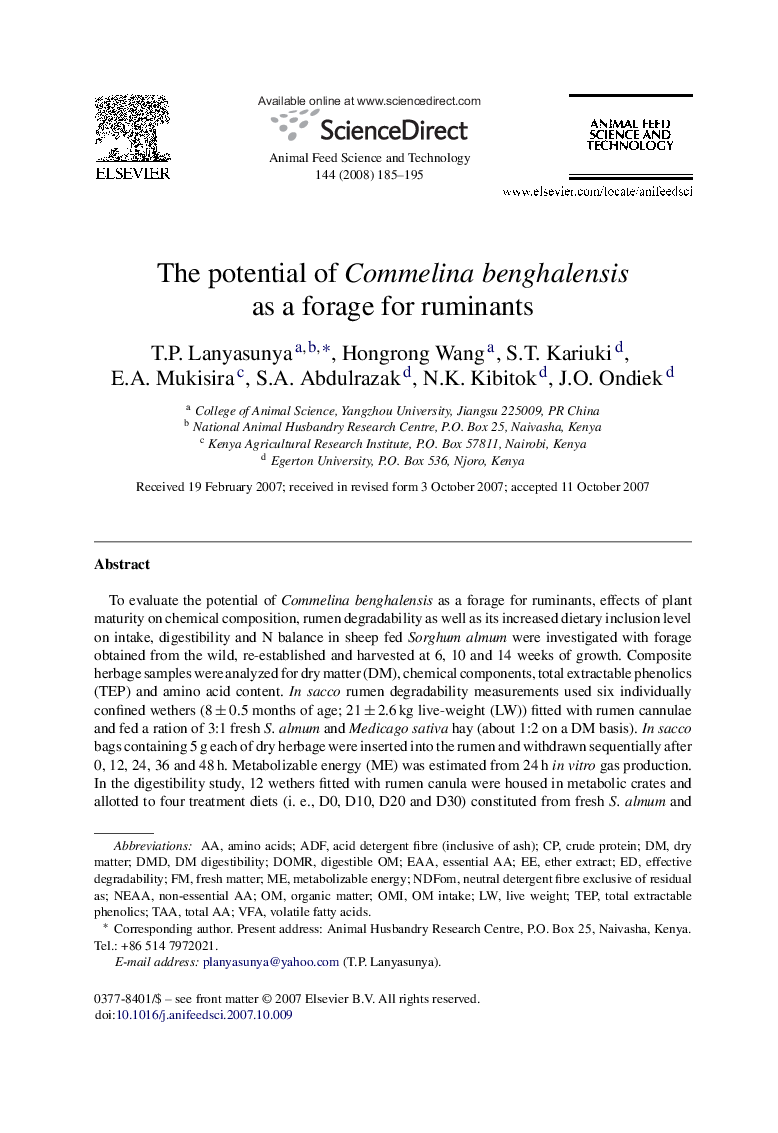| کد مقاله | کد نشریه | سال انتشار | مقاله انگلیسی | نسخه تمام متن |
|---|---|---|---|---|
| 2420775 | 1552468 | 2008 | 11 صفحه PDF | دانلود رایگان |

To evaluate the potential of Commelina benghalensis as a forage for ruminants, effects of plant maturity on chemical composition, rumen degradability as well as its increased dietary inclusion level on intake, digestibility and N balance in sheep fed Sorghum almum were investigated with forage obtained from the wild, re-established and harvested at 6, 10 and 14 weeks of growth. Composite herbage samples were analyzed for dry matter (DM), chemical components, total extractable phenolics (TEP) and amino acid content. In sacco rumen degradability measurements used six individually confined wethers (8 ± 0.5 months of age; 21 ± 2.6 kg live-weight (LW)) fitted with rumen cannulae and fed a ration of 3:1 fresh S. almum and Medicago sativa hay (about 1:2 on a DM basis). In sacco bags containing 5 g each of dry herbage were inserted into the rumen and withdrawn sequentially after 0, 12, 24, 36 and 48 h. Metabolizable energy (ME) was estimated from 24 h in vitro gas production. In the digestibility study, 12 wethers fitted with rumen canula were housed in metabolic crates and allotted to four treatment diets (i. e., D0, D10, D20 and D30) constituted from fresh S. almum and pre-wilted C. benghalensis in a randomized complete block design. The control diet (D0) was 3 kg fresh S. almum (≈535.5 g DM/wether/d about 30 g/kg LW), whereas D10, D20 and D30 were D0 +300, 600 or 900 g of wilted C. benghalensis (≈34, 68 or about 102 g DM/wether/d), respectively. The study lasted for 21 d. Dry matter, fibre and TEP content increased (P<0.001) with maturity of the forage, whereas those of CP and EE decreased (P<0.0001) over the same period. Amino acids (AA) also declined with maturity (P<0.05). Rumen degradability of DM and OM were unaffected, but DM intake increased linearly (P<0.0001) at a decreasing rate (Q: P<0.05) and DM digestibility (DMD) and N intake increased linearly (P<0.01 and P<0.0001, respectively) as level of C. benghalensis in the diet increased. Results indicate that advancing maturity affected chemical composition, but not rumen degradability, of C. benghalensis and also demonstrated that inclusion of C. benghalensis in S. almum diet improved intake, digestibility and N intake, suggesting its potential use as a feed supplement.
Journal: Animal Feed Science and Technology - Volume 144, Issues 3–4, 15 July 2008, Pages 185–195